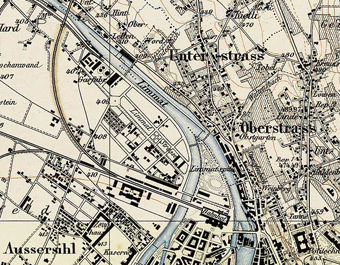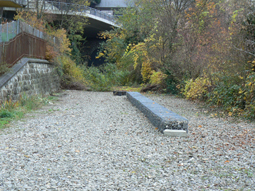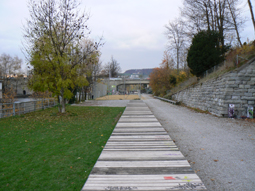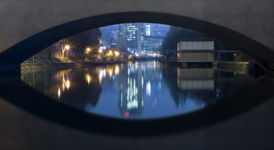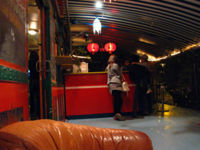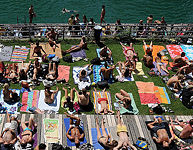Lettenareal
History of a popular park in the heart of Zürich, Switzerland
Rationale: Why is this case study interesting?
This area is a good example of how very different needs (social, environmental, and economics) can be satisfied in one really busy and crowded place. It shows how new elements can be carefully added to existing structures to improve the place without changing its character.
The current trend to higher density in urban structures can also be seen in Zürich. Due to some new railway policy in 1990 a large area of former railroad tracks became new open space in the very heart of the city: The Lettenareal. But before this former railroad area was turned into a public area 15 years passed. During these years there were times when this place become famous for one of the largest drug scenes in the world.
Author's perspective
For about ten years I worked as a gardener. In 2005 I stopped working and began to study landscape architecture at the “Hochschule für Technik Rapperswil”. In summer 2008 I earned my bachelor degree. In autumn of the same year I began with the master studies.
This report about the Lettenareal refers to several aspects of my bachelor studies.
Landscape and/or urban context
The Lettenareal is situated on the right of the river Limmat at the foot of a hill. Because the terrain is very steep an exposed to the south, it was used to grow wine for a long time. At the end of the 19th century part of the hill was removed, to build a railway track. At nearly the same time a dam was built to use the river force for the first electrical power station of Zürich. These measures formed the area at an early stage and the terrain has reminded like this until today.
Cultural/social/political context
The Lettenareal was owned by Swiss federal railways (SBB) until 1995. In 1990 a new railway connection between the main station and the station ‘Stadelhofen’ was opened, which made the track at the Lettenareal useless. The SBB kept this area, although it was unused, for it might serve some purpose in later times.
In 1992 the drug scene settled down there and the SBB earned a lot of criticism for providing the place. In 1995 the area was vacated by the police and then shut off for three years. After years of neglect the old ‘Lettentunnel’ was in danger of collapse. Without the tunnel, the SBB lost interests in this area. After refilling the tunnel the SBB had no more needs for the access to the area either. From that moment on the town could use the whole area as an open space.
History
Because of its interesting historical background the Lettenareal gives example of a rather small area which servers a wide variety of purposes.
The power station and the canal
For several hundred years the flow of the river Limmat has been used for generating energy. To pile up the water it was necessary to build a dam and a canal. In 1892 Zürich got its his first electric power station. Today’s form of the canal is still the same, but since 1935 there has been a newer dam, which can also regulate the water level of the lake of Zürich.
- 1892.jpg
1892, the powerstation is already there
The public swimming pool
For more than 100 years this place has been used for recreational purpose. Swimming only became possible in this place due to the building of the power station and its canal. Since then the area is also known as the public swimming pool ‘oberer Letten’. This way Zürich has generated symbiosis between a recreational and a technical use of the Limmat for a long time.
The railway
In 1873 the railway line between Zürich and Rapperswil was begun to be built. Shortly after it had been started the project was stopped again due to financial obstacles. It had been stopped for 16 years. In the meantime new houses had been built in the places of the originally planned railway line within Zürich. Consequently a new track had to be found for the first part of the connection Zürich – Rapperswil, which led from the main station to the station of ,Stadelhofen’. They were finally linked via a bridge and a tunnel. To make this new track work, parts of the hill had to be removed and give birth to what in the future would be known as the Lettenareal.
The nature reserve
During the years when the area had been shut off a natural succession had started. Not only did ecologically plants return to the area but also a population of lizards inhabited the Lettenareal. Therefore part of the area was kept as nature reserve when the area was turned into a public space. This nature reserve works although it is situated in the centre of an urban area and is frequented a lot by citizens who look for recreation, especially in summer.
Spatial analysis of area/project/plan
The things that strongest forms the Lettenareal is the power station’s canal. It is long and narrow, which is the spatial character of the whole area. The structural features of the railway line are still visible; long and narrow like the canal. The office ‘Rotzler Krebs Partner’ planning the new public space took on/over this given shape of the area and designed accordingly in long and narrow lines/forms. Some elements are gabions, wooden gangplanks and tree rows, all supporting the spatial pattern of the park. The Lettenareal is split in two different areas, which can be distinguished because of the different materials used; for visitors the ground is formed with a smooth sandy surface, for the lizards it is formed with ballast (broken stones).
Core questions working group open spaces
How does the design of an open space contribute to a run down neighbourhood?
A useless/run down open space can have effects to a big area. In the case of the Lettenareal it effected the whole adjacent quarter, and even the reputation of the town. The cases with the Needelpark and the Lettenpark are worst case sceneries but they happen.
These cases show that one of the real important pre-conditions is the security of open spaces, and that visitors feel safe. Most people feel safe when the place is well visited, and to be so the space has to be attractive. Attractiveness can best be produced with a good and adequate range for regeneration possibilities. What to offer depends on the users respectively.
How are open spaces linked to the adjacent areas?
The Lettenareal is an isolated place. On one side there is a steep flank of a hill, on the other side there is the dam and behind a river. There are only two entrances at both ends of this longish area.
In general in Zürich all open spaces are cellular applied, well linked for pedestrians and cycle paths and the public transport is also well linked.
How are open spaces used?
(e.g. which groups meet there, which functions does an open space fulfil)
This area is laid-out for young people. There are beach-volleyball courts, a skater area, two restaurants and a long platform for swimmers with a sunbathing area. This makes this area popular in summer, but in winter it is deserted.
Which elements make an open space successful and attractive?
-Look at how are open saces used-
In general different users have different requirements. There is a need to catch up of areas for children and elderly people. Especially places for elderly people will become very important considering the development of the population. Today most of the open spaces, as the Lettenareal, are designed only for the working population.
How can the historical background of an open space be shown to the public?
There are different ways. One of the conditions for planning Lettenareal was to change just as little as necessary. There are only few new elements, which upgrade the use of the area but which leave the character is it was. On both ends of the area there are still the lines from the railway but without the wheel tracks. And at the west end you can still see the railway station.
Analysis of program/function
This area has been created for two main groups of users: On the one hand it is meant to be a place for people to relax. It’s a good place for swimming, playing beach volleyball and skateboarding. The most popular activity is to go there and have a drink and to see and be seen. There are two restaurants where you can buy drinks and snacks. One, an old rail car, is there for whole year, the other is a movable two floor building, which is only there in summer.
On the other hand the Lettenareal is meant to be a nature reserve. In this part of the park there live endangered plants and animals.
Analysis of design/planning process
The project was planned in a corporative process. The city’s department ‘Grün Stadt Zürich’, which is the owner of the area, organized workshops with residents, representatives from the quarter and conservationists. These various interests influenced the planning process. Rotzler and Krebs Partner GmbH, a landscape architecture office from Winterthur (Switzerland) was responsible for the planning. For this work they obtained a Swiss architecture price in bronze in 2005.
Analysis of use/users
The Lettenareal is generally used by locals. Most visitors are between twenty and forty years old and from all social classes and ethnic groups. Families, children or retired people are not well represented there, because the park doesn’t offer them anything that suit their needs. They mostly use the park as a means of passing on to other locations.
Future development directions
In the future there will be no need of bigger changes in the Lettenareal. The development has finished. Maintenance, such as keeping the open features free from overgrowth, has now major priority. Cleaning the litter, especially after weekend evenings is eminently important, too. Along the river Limmat other projects are still being planned. The general aim of these other projects is to better involve the river into the city’s everyday life. Accessibility to the river for people is to be improved as is moving along the rivers banks for the various animal populations.
Peer reviews or critique
- Has the area/ project/plan been reviewed by academic or professional reviewers?
- What were their main evaluations?
Pleas add references, quotes...
Points of success and limitations
In my opinion the Lettenareal is a successful project. The recreation functions the park offers seem to work just as well as its aim to protect an important natural habitat. Even if sometimes the Lettenareal is very crowded. The limitation to the project is the small size of this area. Unfortunately there is no more space to enlarge it. In winter the Lettenareal is only used for strolling along the canal, because the area offers no attractions in this time.
What can be generalized from this case study?
This project was quite cheap, compared to others similar projects. The place has kept its character and succeeds to serve citizens interests as well as to protect plants and animals. This success is due to either the office planning the park and the process of how these plans were implemented including the locals. The planning is well embedded into the area and its history.
Which research questions does it generate?
Short statement plus background notes
Image Gallery
- Summer2.jpg
your image text
- Lizard.jpg
in the area lives a big population of lizards
- Yourimage.jpg
your image text
- Yourimage.jpg
your image text
- Yourimage.jpg
your image text
- Yourimage.jpg
your image text
- Yourimage.jpg
your image text
[[Image:|left]]
References
Please add literature, documentations and weblinks
About categories: You can add more categories by copying the tag and filling in your additional categories asdfasdf

